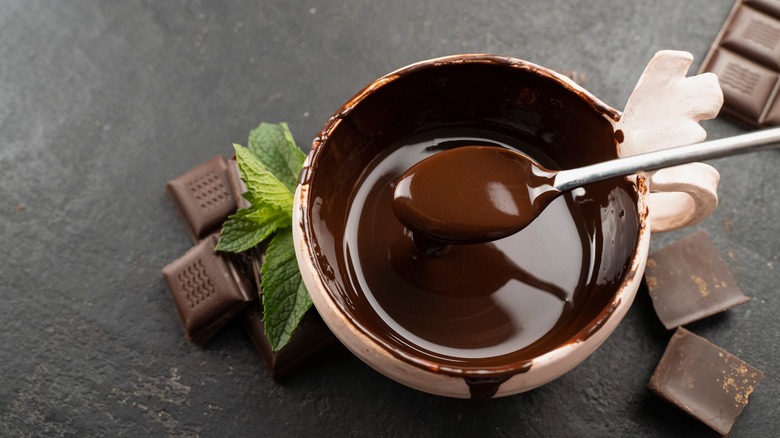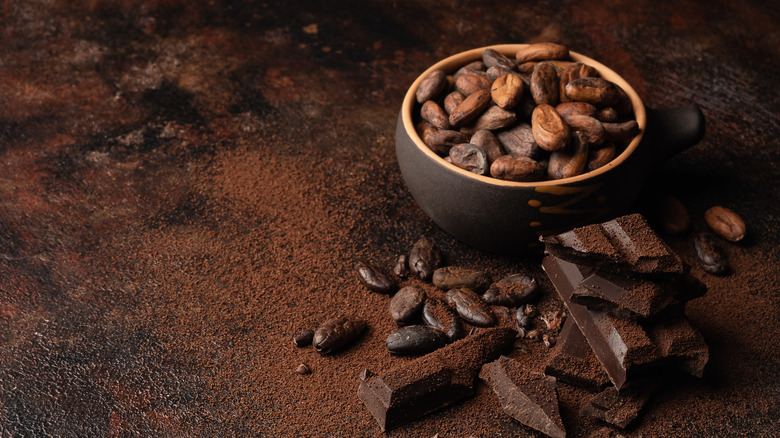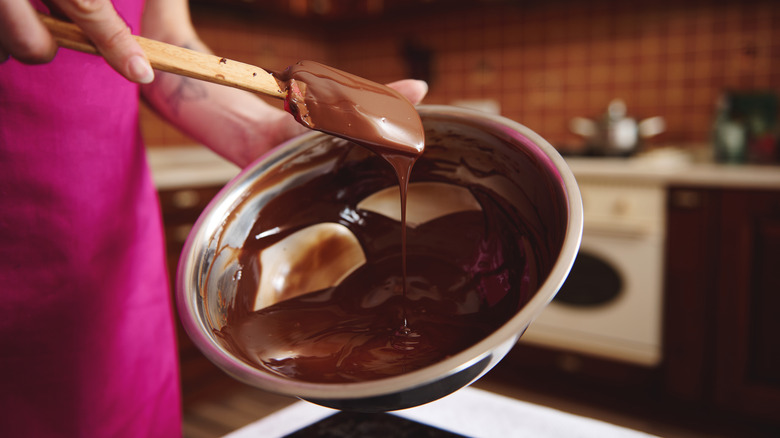Water Is Chocolate's Worst Enemy. Here's Why
We've all been there. You're standing at the stove melting some beautiful milk or dark chocolate over low heat, just as the recipe instructed. You stir it gently, but suddenly, your pool of liquid velvet has transformed into a thick, grainy mess. What in the world happened to that beautiful, melty goodness?
That grittiness means your chocolate has seized, according to Science of Cooking. Odds are, you inadvertently added chocolate's worst enemy: water. Even a drop or two of water on the spoon can make chocolate seize, notes Chocolate Phayanak. That means the ingredients in the chocolate grabbed onto the water and clumped up, becoming insoluble.
So, why can you melt chocolate into a large amount of liquid, but just a tiny bit of water creates a grainy mess? Can this disaster be fixed? The answer lies in a bit of food science. (Don't be scared; it's easy to understand.)
What is seizing?
Seizing happens when chocolate turns into a stiff, dry, and unworkable mixture. This happens because of the nature of chocolate; it's a solid made up of chocolate liquor that contains cocoa solids and cocoa butter and sugar, per Hotel Chocolat. This process removes almost all of the water from those ingredients, creating a web of fat (cocoa butter), sugar, and cocoa solids, according to Fooducation. When you melt chocolate, these components separate evenly and smoothly in the heat.
Unfortunately, sugar is hydrophilic, meaning it attracts and holds onto water, according to Biology Online. That little bit of water you added creates a kind of syrup with the sugar crystals that attracts even more sugar and cocoa solids, making that mess in just a few seconds. Now there are big clumps in the fat matrix. Believe it or not, even steam can make chocolate seize. (That's why in recipes, when you're told to melt chocolate in a double boiler, there are very stern instructions about not letting the water boil.)
But why can you melt chocolate in a large amount of liquid? The answer is proportion. Adding more water means that the water is the main component in the solution instead of fat, and the sugar, cocoa solids, and cocoa butter evenly distribute in the liquid. Fooducation says to use at least a tablespoon of water for every 2 ounces of chocolate if you want to do this.
Can seized chocolate be fixed?
You can fix seized chocolate with a couple of methods. But be aware that if you're melting chocolate to coat candies, if it's seized, you have to start all over. These methods for fixing seized chocolate mean your chocolate coating won't be pure because of what you need to add: fat or water.
If you're using the chocolate to make cookies or a cake, you can add more fat, according to Cuisine at Home. But you have to use a fat that doesn't contain any liquid. Butter is about 16 to 18% water, per Taste, so that's out. Use vegetable shortening or vegetable oil; just about a teaspoon, and stir it vigorously into the seized chocolate until it's smooth again.
If you're going to use the chocolate to make a sauce, add just a bit of boiling water, per America's Test Kitchen. This dissolves the sugar clumps and stabilizes the mixture. Use a teaspoon of boiling water and, again, stir like crazy. Add a tiny bit more boiling water if necessary.


